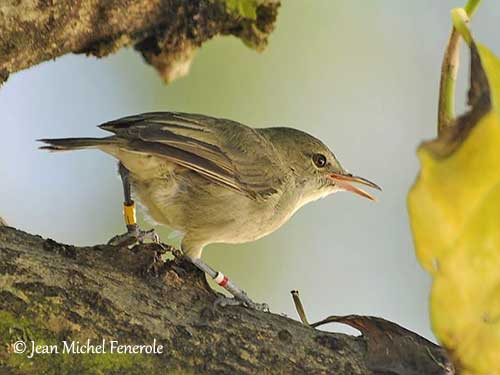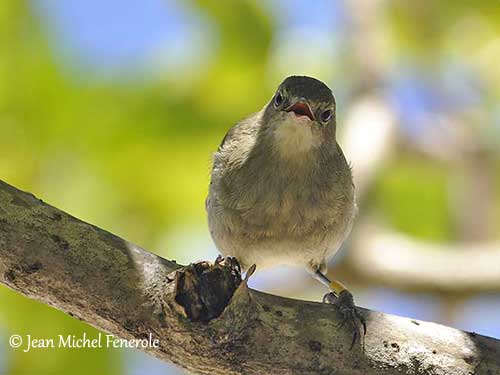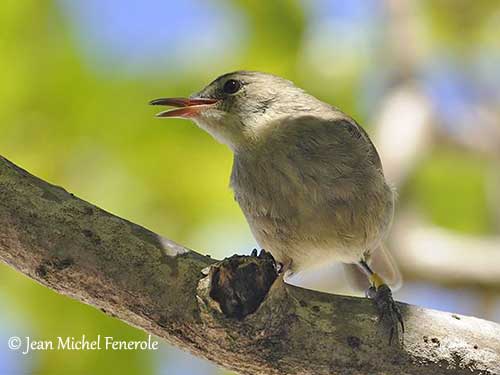
Fr: Rousserolle des Seychelles
Ang: Seychelles Warbler
All: Seychellenrohrsänger
Esp: Carricero de Seychelles
Ita: Cannaiola delle Seychelles
Nd: Seychellenrietzanger
Sd: seychellsångare
Photographer:
Jean Michel Fenerole
Photos d’Oiseaux du monde
Text by Nicole Bouglouan
Sources:
HANDBOOK OF THE BIRDS OF THE WORLD Vol 11 by Josep del Hoyo, Andrew Elliott and David Christie - Lynx Edicions - ISBN: 849655306X
L’ENCYCLOPEDIE MONDIALE DES OISEAUX - Dr Christopher M. Perrins - BORDAS - ISBN: 2040185607
Reed and Bush Warblers Par Peter Kennerley, David Pearson – Helm Identification Guide – Editeur: A&C Black, 2010 – ISBN: 1408134012, 9781408134016
Wikipedia, the free encyclopaedia
AQUA-FIRMA – Water – Wilderness – Wildlife
Seychelles Warbler
Acrocephalus sechellensis
Passeriformes Order – Acrocephalidae Family
INTRODUCTION:
The Seychelles Warbler was historically more widespread, but for a time, this endemic species was critically endangered and confined to Cousin Island in small native woodland. From 29 individuals in 1959, the numbers were increasing gradually thanks to habitat management, and the population was estimated at 323 individuals in 1997. This population was suspected to be stable.
Several birds were translocated to small close islands such as Aride and Cousine where the populations reached respectively 1,600 and 137 individuals in 1997. Other translocations to other islands were also successful. Thanks to these measures, the future survival of this species which numbers are increasing appears now more secure.
However, the Seychelles Warbler is still listed as Near Threatened because other threats such as the limited genetic variation, could lead to the lack of genetic resistance to introduction of new pathogens.
DESCRIPTION OF THE BIRD:
Biometrics:
Length: 14 cm
Wingspan: 17 cm
Weight: M: 16-17 g – F: 15 g
The Seychelles Warbler adult has almost uniform olive-brown plumage.
Head and upperparts are dull yellowish olive-brown with greenish wash. The rump is slightly paler. On the upperwing, the flight-feathers are darker and browner. The long tail is dark with white tips to rectrices.
The underparts are paler, mostly buffish yellow, but belly and flanks are greyish olive, whereas the vent is pale greyish. The breast shows grey-yellow streaks and the throat is pale yellow.

On the head, we can see a whitish supercilium and a dark eye stripe. Lores and eyering are variably pale.
The long, slim bill is horn-coloured with pink-orange base. The eyes are red-brown. Legs and feet are blue-grey.
Male and female are similar.
The juvenile resembles adult but its tail is much shorter. It has slate grey eyes, becoming brown with age.
RANGE:
The Seychelles Warbler is endemic to Seychelles Islands and occurs on five islands, following translocation of the species from Cousin Island to Aride, Cousine and Denis Islands, and more recently on Fregate Island.
HABITAT:
The Seychelles Warbler occurs in dense shrubland and in tall forests. It frequents the thick bushes at the edges of old coconut plantations, and can be found in mangroves and coastal vegetation.
CALLS AND SONGS: SOUNDS BY XENO-CANTO
The Seychelles Warbler has a wide repertoire of songs, including a harsh “check” in alarm. But we can also hear repeated “pea-cher, pea-cher”, a more melodious, complex warbling song, and a quieter “twee-twee-twee…” sub song. While the bird is foraging, it produces a clacking sound with the bill.
BEHAVIOUR IN THE WILD:
The Seychelles Warbler feeds primarily on insects such as bugs and their eggs, beetles, bees and ants. Spiders are also taken and occasionally small geckos.
It forages for insects among the foliage, but it also comes sometimes to the ground. The food items are gleaned from leaves and twigs, and insects can be sometimes caught in the air.
A well-defined territory is established by the pair and occupied all year round.
The Seychelles Warbler is a co-operative breeder, and the young from previous broods, usually females, often act as helpers. They are territorial and monogamous.
From several observations and studies, the male owner of the territory is more often observed fighting at borders shared with unrelated or unfamiliar neighbour. It is usually less active towards a known related neighbour.
This is less important for the female which fights equally will all neighbours.
The Seychelles Warbler is sedentary.
The flight is hesitant and sluggish.

REPRODUCTION OF THIS SPECIES:
The breeding season may extend all year round depending on insect availability, with peak between May and September. This species produces one brood per year.
The nest of the Seychelles Warbler is cup-shaped and made with coconut fibres and grass, and lined with softer materials such as wool, cotton rags, plastic… This structure is placed within high tree branches, between 6 and 20 metres above the ground in mangroves, bamboos and other wooded habitats.
The female lays 1-2 eggs and incubates alone during 15 days. Both parents feed the chicks that leave the nest long before to be able to fly. The young depend on adults for several months.
Some young, mainly females, remain on the natal territory and often act as helpers. They help in territory defence and chick feeding.
The young birds often stay as helpers on high-quality territories rather than moving to low-quality ones as breeders. On high-quality territories, the females produce 90% of daughters, whereas there are 80% of sons on low-quality territories. When females are moved to high-quality territories, they produce two-egg clutch instead of a single egg.
These observations suggest that the Seychelles Warbler may have a pre-ovulation control of offspring sex ratio.
PROTECTION / THREATS / STATUS:
The Seychelles Warbler has restricted range on five tiny islands in Seychelles. The species was formerly threatened by habitat destruction and introduced predators, but also by human disturbance.
Translocation of the species to other islands of the archipelago involved the increase of the population. Translocation to very high-quality habitat on Aride and Cousine Islands induced numerous females to produce two eggs instead of single-egg clutches. Other translocations to Denis and Fregate Islands occurred in the following years and were successful too.
The population on the five islands is estimated at 320 (Cousin), 210 (Cousine), 1,850 (Aride), 600 (Denis) and 200 (Fregate).
Since 2007, the global population has increased strongly with 2,800 adults in 2014 and 3,000 adults in August 2016. This increase is the result of habitat management and translocations.
However, the Seychelles Warbler is currently still listed as Near Threatened.
